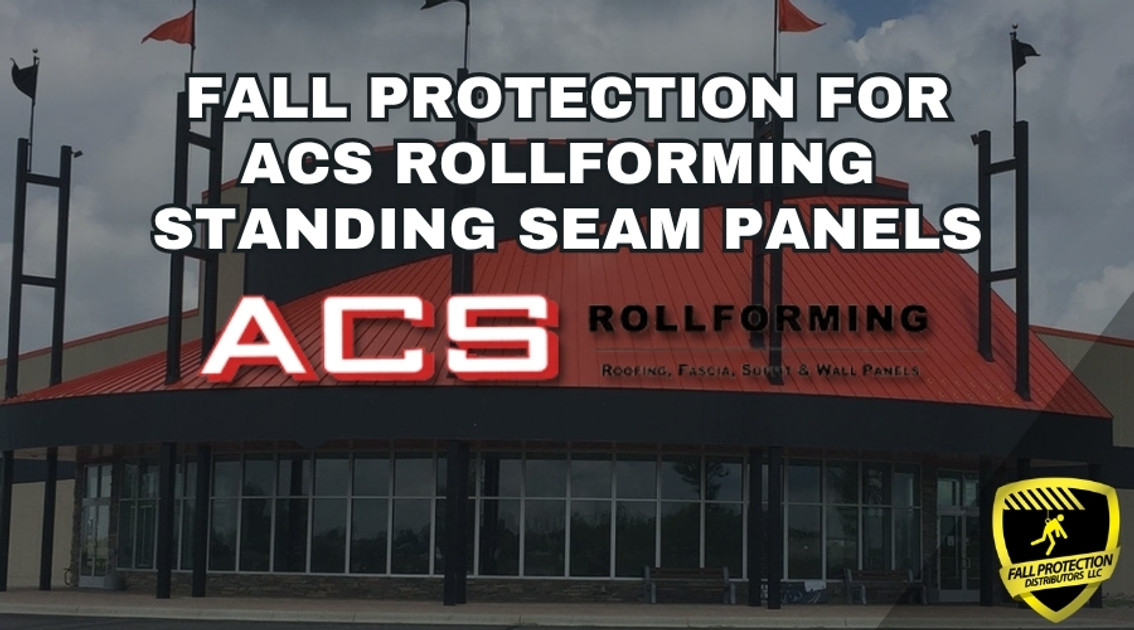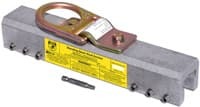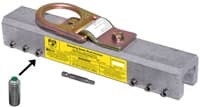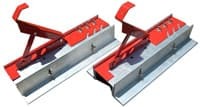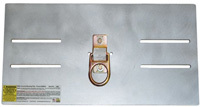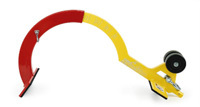Fall Protection For ACS RollForming Roofs
Posted by Howie Scarboro - CEO Fall Protection Distributors, LLC on Jun 6th 2025
See the Roof Anchor Compatibility Chart for ACS Rollforming Standing Seam Panels.

Who Is ACS Rollforming?
ACS Rollforming delivers precision-crafted metal roofing systems committed to safety, performance, and architectural detail.
Architectural Construction Services, Inc. (ACS Rollforming) is a leading metal fabrication company based in Eagan, Minnesota. Specializing in architectural-grade standing seam roofing systems, ACS serves contractors, builders, and architects across the Midwest with custom-formed panels, flashings, and accessories. Their roll-forming capabilities enable precise control over panel width, seam height, and profile shape, making them a top choice for commercial, institutional, and high-end residential projects. Known for quality craftsmanship and hands-on support, ACS Rollforming offers more than just panels—they provide project-ready solutions backed by experience, engineering insight, and a focus on long-term building performance.

Why Compatible Fall Protection Products Are Critical for Standing Seam Roof Systems
Using the wrong anchors on standing seam metal roofs can damage the panels, cause system failure, and pose significant safety risks.
Standing seam metal roofs are unique in their construction—floating seams, concealed clips, and fastener-free surfaces are essential to their strength, flexibility, and weather resistance. However, these same features also make them incompatible with traditional fall protection anchors that rely on screws or nails. Penetrating the panel with standard anchors can void the manufacturer's warranty, cause roof leaks, and permanently damage the seam profile. That's why contractors and maintenance crews must use non-penetrating fall protection systems that clamp securely to the seam without compromising the structure. Devices like the SSRA1 Seam Anchor provide OSHA-compliant tie-off points while preserving the roof's design and functionality. Compatible fall protection isn't just about following code—it's about protecting your workers, your roof system, and your reputation on every job.
Narrow Batten Strip Standing Seam Panels

ACS's Narrow Batten Strip panels offer flexible dimensions and a clean batten-seam look but require specialized fall protection.
See the Roof Anchor Compatibility Chart for ACS Rollforming Narrow Batten Strip Standing Seam Panels.
The Narrow Batten Strip Standing Seam panel from ACS Rollforming is versatile and has architectural appeal. Panel leg heights are adjustable between 1/2 and 1 1/2 inches, with panel widths ranging from 12 inches to 24 inches. These panels are roll-formed on-site or on the rooftop for custom-fit applications.
Material options include 26-gauge and 24-gauge steel, 0.032-inch aluminum, and copper in 16-ounce or 20-ounce thicknesses. A curved version with the 5/8-inch seam height configuration adds further architectural flexibility. This panel system is ideal for designers seeking a batten-style standing seam profile with no visible fasteners or disruption to the panel flow.
Fall Protection For Narrow Batten Strip Standing Seam Panels
SSRA seam anchors are incompatible with batten cap systems; however, the Ridge Pro Steep Assist provides a reliable tie-off on sloped roofs.
Due to the batten cap seam structure of the Narrow Batten Strip panel, SSRA1 Seam Anchors and their corresponding accessories (SSRA2 Adjustable Roof Jack and SSRA3 Anchor Plate) are incompatible. These panels do not offer a seam profile suitable for clamping seam-mounted anchors without compromising the integrity or aesthetics of the panel's batten.
For roof slopes with pitches between 6/12 and 12/12, the Ridge Pro Steep Assist Anchor offers an ideal alternative. This anchor hooks securely over the ridge without any fasteners, making it an excellent option for homeowners, contractors, or maintenance teams who need OSHA-compliant fall protection that won't damage the roofing system. The Ridge Pro enables workers to maintain a 100% tie-off from ladder transition to roof navigation, especially on steep or slick metal surfaces.
A qualified safety professional should inspect curved roofs for projects involving curved Narrow Batten Strip panels to determine job-specific fall protection strategies.
Double Lock Standing Seam Panels

Double Lock panels from ACS offer adjustable widths and high-strength materials, which are ideal for architectural and structural roofing applications.
See the Roof Anchor Compatibility Chart for ACS Rollforming Double Lock Standing Seam Panels.
ACS Rollforming's Double Lock panels combine versatility with robust performance, making them popular for commercial, institutional, and high-end residential projects. Available in 16, 18, and 20-inch widths, these panels can be 22, 24, or 26-gauge steel and aluminum, copper, or zinc. Depending on the application, panel seams can be one inch, one and a half inches, or two inches high—each secured with clips engineered to accommodate thermal expansion and contraction. Optional stiffening ribs improve strength, and ACS provides tool rentals for both power and hand seamers, ensuring a proper mechanical lock during installation. These panels offer exceptional performance and long-term durability, whether installed flat or on a slope.
Fall Protection For Double Lock Panels
SSRA1 seam anchors and accessories provide a comprehensive fall protection system for 22- and 24-gauge steel panels; the Ridge Pro is compatible with most roof types.
For straight Double Lock panels in 22- and 24-gauge steel, contractors can confidently use the SSRA1 Seam Anchor, SSRA2 Adjustable Roof Jack Adapter, and SSRA3 Anchor Plate to create a complete fall protection system that won't compromise the panel seams. The SSRA1 clamps securely to compatible seams using a patented design with cupped tip set screws that grip without penetration. It provides a certified 5,000-pound tie-off point for a single worker in either fall arrest or restraint mode.
Adding the SSRA2 Roof Jack Adapter turns the SSRA1 into a platform for temporary scaffolding. Contractors can mount 2x10 walk boards across multiple anchors to create a stable working surface on steep or slick metal roofs. These walkboards assist with panel installation, seam sealing, flashing, and inspections—while providing workers with OSHA-compliant tie-off and support.
The SSRA3 Anchor Plate is another powerful add-on. It mounts to the SSRA1 and includes two integrated D-rings, making it the perfect base for a temporary horizontal lifeline system. Teams can connect a 100-foot lifeline, allowing multiple workers to move safely along the length of the roof while remaining tied off at all times. It's a seamless system that protects workers, enhances productivity, and maintains roof integrity.
For permanent safety installations, consider the Super Anchor 120′ Standing Seam Horizontal Lifeline Kit. It features a galvanized steel cable lifeline that can be left in place long-term, all without penetrating the panel system.
For aluminum, copper, zinc, or 26-gauge steel panels, the Ridge Pro Steep Assist Anchor is the most suitable alternative for roofs with pitches ranging from 6/12 to 12/12. The Ridge Pro hooks securely over the peak without drilling or fasteners, allowing workers to transition from ladder to rooftop while staying 100% tied off. It's perfect for quick inspections, minor repairs, or short-duration work where seam-mounted anchors are unsuitable.
Before installing the SSRA1 on any snap-lock style seam, we recommend performing a test fit to confirm full compatibility, especially on panels with variable locking dimensions or unique seam profiles.
Snap Lock Standing Seam Panels

ACS Snap Lock panels provide architectural appeal with concealed clips and adjustability, making them suitable for aesthetic and structural roofing applications.
See the Roof Anchor Compatibility Chart for ACS Rollforming Snap Lock Standing Seam Panels.
The Snap Lock panel from ACS Rollforming offers a sleek and modern finish, providing flexibility for various project types. Available in 12, 16, and 20-inch widths with a 1.75-inch seam height, these panels are 22, 24, or 26-gauge steel, 0.032-inch aluminum, or copper. The concealed clip fastening system allows for natural thermal expansion and contraction, improving long-term performance without stressing the panel seams. Depending on the project's structural requirements, installers can apply the panels over open purlins or solid decking. Optional features include stiffening beads for added strength and a revealing profile with a maximum depth of 1 inch. With their crisp lines and clean appearance, Snap Lock panels are popular for high-end residential and light commercial applications.
Fall Protection For Snap Lock Panels
SSRA products offer a non-penetrating fall protection solution for compatible steel Snap Lock panels; the Ridge Pro covers all other applications.
When working on Snap Lock panels made from 22- or 24-gauge steel, the SSRA1 Seam Anchor provides a reliable, OSHA-compliant tie-off point without compromising the panel's structure or aesthetics. The anchor clamps directly onto the 1.75-inch seam using cupped tip set screws, creating a solid 5,000-pound-rated tie-off point for a single worker. It's a fast, non-invasive way to get fall arrest or restraint protection without drilling through the panels or voiding warranties.
For greater flexibility, the SSRA2 Adjustable Roof Jack Adapter mounts on top of the SSRA1 anchor and supports standard 2x10 wooden walkboards. This setup creates a secure working platform across the roof. It enhances safety during panel installation, flashing work, or ridge cap sealing—especially on sloped surfaces.
Contractors looking to accommodate multiple workers will benefit from adding the SSRA3 Anchor Plate. It installs directly onto the SSRA1 base and includes two integrated D-rings to support a temporary horizontal lifeline system. This setup enables safe movement along the roofline for multiple crew members while maintaining a secure connection.
Together, these SSRA components form a flexible and modular fall protection system that meets OSHA standards while maintaining the integrity of the Snap Lock panel. However, some snap-lock seam profiles vary by manufacturer or project specs, so we strongly recommend a test fit of the SSRA1 anchor before starting any job to confirm compatibility.
Another product to consider is the Super Anchor 120′ Standing Seam Horizontal Lifeline Kit. It has a galvanized steel cable lifeline that is intended for permanent installations without any panel penetrations.
For aluminum, copper, and 26-gauge steel Snap Lock panels, or when a test fit reveals incompatibility, the Ridge Pro Steep Assist Anchor is the most suitable solution for fall protection. It hooks securely over the ridge of a roof without fasteners and provides a tie-off point for a worker on 6/12 to 12/12 slopes. It's beneficial for quick jobs like inspections, minor repairs, and maintenance tasks.
Nail Strip Panels

Nail strip panels offer fast installation with a clean standing seam look, making them ideal for residential and light commercial use.
See the Roof Anchor Compatibility Chart for ACS Rollforming Nail Strip Standing Seam Panels.
ACS Rollforming's Nail Strip panels are known for their speed and simplicity on the job site. Available in 12, 15, and 16-inch widths with a 1.0-inch rib height or in 12, 16, and 20-inch widths with a 1.5-inch rib height, these architectural and structural standing seam panels fasten through pre-slotted holes. This versatility allows for limited thermal movement without the need for clips.
Panel options include 22, 24, and 26 gauge steel, .032 aluminum, and copper in 16-ounce and 20-ounce thicknesses. Stiffening ribs and striations are available, and job-site or rooftop roll forming is supported. With a 4-inch lock dimension and machine-cut panel widths available, Nail Strip panels provide reliable performance in a wide range of roofing projects.
Fall Protection For Nail Strip Panels
SSRA1 anchors and accessories provide a reliable tie-off solution for 22- and 24-gauge Nail Strip panels without compromising the roof.
For 22 and 24-gauge steel Nail Strip panels, the SSRA1 Seam Anchor offers a fully non-penetrating, OSHA-compliant fall arrest solution by clamping directly to the standing seam. This anchor supports a 5,000-pound tie-off point, preserving the panel's finish and structure. When paired with the SSRA2 Adjustable Roof Jack Adapter, crews can safely install walkboards between anchors, providing greater stability and comfort while working on steep slopes.
For longer spans or multiple-user applications, the SSRA3 Anchor Plate mounts on top of the SSRA1, creating two attachment points for a temporary horizontal lifeline. This setup enables multiple workers to remain safely tied off across an extended roof section—ideal for roof installation, maintenance, or repair work.
The Super Anchor 120′ Standing Seam Horizontal Lifeline Kit is intended for permanent installations and feautures a galvanized steel cable lifeline.
Because seam shape can vary across Nail Strip profiles, we recommend conducting a test fit before fully deploying the SSRA system on a new job site.
For 26-gauge steel and all other substrates, such as aluminum or copper, the Ridge Pro Steep Assist Anchor is the most suitable option. This non-penetrating device hooks over the ridge cap, allowing for a 100% tie-off during access and transition on roofs with a 6/12 to 12/12 pitch. It's beneficial during quick service jobs, inspections, or when installing penetrations near the ridge.
Wide Batten Seam Panel

This is a bold, architectural roofing option with traditional batten cap styling and versatile metal choices for both modern and historic applications.
See the Roof Anchor Compatibility Chart for ACS Rollforming Wide Batten Seam Standing Seam Panels.
The Wide Batten Seam Panel offered by ACS Rollforming features prominent batten cap seams that enhance visual appeal while delivering rugged performance. These panels are available in three batten widths—1.5 inches, 2 inches, and 2.25 inches—each with a rib height of 1.625 inches. Depending on project needs, clips are available in three leg heights: 5/8 inch, 7/8 inch, and 1.375 inches. This panel line is well-suited for upscale residential, civic, or religious buildings where appearance and weather resistance are critical.
Fabrication options include 26-gauge and 24-gauge steel, .032-inch aluminum, and copper in 16-ounce and 20-ounce thicknesses. With job site and rooftop roll forming available, these panels offer flexibility and efficiency for installers working on complex or large-scale roofing systems.
Fall Protection For Wide Batten Seam Panels
Due to the full batten cap seam design, SSRA seam anchors are not compatible—use the Ridge Pro Steep Assist for safe tie-off access.
Wide Batten Seam Panels cannot be used with SSRA1 Seam Anchors, SSRA2 Roof Jack Adapters, or SSRA3 Anchor Plates because the batten cap profile prevents proper clamp engagement. For safety on these panels, especially on steeper slopes between 6/12 and 12/12, the Ridge Pro Steep Assist Anchor is the best solution.
The Ridge Pro hooks securely over the ridge cap without penetrating the panel, providing a stable and reliable tie-off point while allowing the worker to transition safely from a ladder to the roof and maintain 100% tie-off during movement along the ridge. This feature makes it an excellent option for inspections, minor repairs, cleaning tasks, or service jobs that don't justify installing a complete lifeline system.
Radius/Curved Panels

A specialty solution for domes, barrel vaults, and arched rooflines—ACS curved panels blend form and function with architectural elegance.
See the Roof Anchor Compatibility Chart for ACS Rollforming Radius/Curved Seam Standing Seam Panels.
ACS Rollforming offers the option to curve many of its standing seam panel profiles, allowing for a tailored fit to meet the needs of complex architectural designs. Whether installing a barrel-vaulted canopy, a domed structure, or any radius roof configuration, these panels provide visual impact and weather-tight performance. Depending on the panel type and material, curving is available for select leg heights and seam configurations.
Radius panels are 26-gauge or 24-gauge steel, 0.032-inch aluminum, or copper. They are often roll-formed on-site to achieve a precise fit. These custom-formed panels enable continuous, seamless curvature, making them ideal for high-end architectural projects and historically inspired structures.
Fall Protection For Radius and Curved Panels
Curved panels require a site-specific evaluation—SSRA products are not compatible. Always consult a safety expert before anchoring.
Standing seam panels curved or radiused are incompatible with seam-mounted fall protection anchors such as the SSRA1, SSRA2 Roof Jack Adapter, or SSRA3 Anchor Plate. The bending of the seams during the curving process alters their structural profile, rendering them unsafe for use with clamp-on anchors.
We strongly recommend that a qualified fall protection professional assess any radius or curved roof before selecting anchor points or safety gear. Only a trained expert can determine the safest and most compliant fall protection method for these unique roof designs.
Metal Roof Anchor Panel Compatibility For Metal Central
| Narrow Batten Strip 22-24 ga. |
Double Lock 22-24 ga. |
Nail Strip 22-24 ga. |
Snap Lock 22-24 ga. |
Wide Batten 24-26 ga. |
Radius Curved |
|
|---|---|---|---|---|---|---|
| NO | YES | YES | YES | NO | NO | |
| NO | YES | YES | YES | NO | NO | |
| NO | YES | YES | YES | NO | NO | |
| NO | YES | YES | YES | NO | NO | |
| YES | YES | YES | YES | YES | NO |
Contact Us For More Information
For further details on roofing solutions and fall protection systems, please get in touch with us at 863-703-4522 or www.StandingSeamRoofAnchor.com. Let's work together to make your roofing projects safe, beautiful, and built to last. For more safety tips, refer to OSHA's 48-page Fall Protection Manual. Once you have determined the most suitable anchors for your roof system, download our free Anchor Inspection Form.
Safety Tips For Standing Seam Roofs
Install Permanent Roof Anchor Systems
When crews return to the same roof again and again, permanent anchors are more than just convenient—they're essential. These fixed tie-off points stay in place year-round, offering fast, reliable protection for HVAC maintenance, inspections, and more. Because they eliminate repeated setups and protect the roof from damage, they’re an ideal long-term solution for commercial facilities.
Use Specialized Anchor Systems for Standing Seam Roofs
Not all anchors are created equal—especially on standing seam roofs. Traditional anchors that rely on penetration can destroy the very seams designed to keep the building watertight. Instead, opt for seam-mounted anchors that clamp on securely without piercing the metal. They provide a 5,000-pound tie-off point while preserving the roof’s integrity and warranty.
Consult Experts for Curved Metal Panels
Curved roofs may look impressive, but they’re a challenge when it comes to fall protection. Their unique geometry means standard anchors won’t work—and could even fail under load. Always bring in a qualified fall protection expert before anchoring to a curved panel. They can recommend purpose-built solutions that protect both workers and the roof’s structure.
Develop OSHA-Compliant Safety Plans
A thorough safety plan doesn’t just help you check a box—it helps prevent accidents before they happen. Good plans are tailored to the jobsite, updated frequently, and include everything from rescue protocols to clearly defined crew responsibilities. When your whole team understands the plan, safety becomes a shared mission instead of a solo task.
Equip Workers with High-Quality Safety Gear
Reliable gear builds trust. Workers are far more likely to use their harnesses, lanyards, and lifelines correctly when the equipment fits well, feels good, and inspires confidence. Make sure every piece of gear is OSHA-certified, regularly inspected, and suited to the work being done. Comfort and compliance should always go hand in hand.
Ensure Proper Footwear for Stability
Footwear may seem like a minor detail, but on a slick metal roof, it's your first line of defense. Choose boots designed for roofing—ones with high-grip soles, strong ankle support, and solid tread. Proper footwear reduces slips, boosts balance, and helps prevent fatigue throughout the workday.
Encourage the Use of Trauma Straps
Falling is dangerous—but hanging in a harness afterward can be just as deadly. Trauma straps allow a suspended worker to relieve pressure by standing in their harness, improving circulation and buying critical time for rescue. They’re lightweight, inexpensive, and should be part of every harness on site.
Set Up Protective Guardrail Barriers for Work Zones
Sometimes the best fall protection doesn’t tie you off—it keeps you out of danger in the first place. Guardrails define high-risk areas like skylights and roof edges, acting as a visual and physical barrier. Easy to install and highly effective, they’re a must-have for zones where mobility and awareness are crucial.
Prioritize Ladder Safety Training
Before your crew ever steps foot on the roof, they’re climbing a ladder—and that climb needs to be safe. Reinforce the basics: stable placement using the 4-to-1 rule, three points of contact, and visual inspection for defects. Ladder safety may seem simple, but it’s one of the most important—and most overlooked—elements of roof work.
Promote a Culture of Safety
Safety isn't enforced—it’s embraced. It comes from daily reminders, open communication, and a sense of shared responsibility. When teams hold each other accountable, report near misses, and speak up without fear, the whole jobsite improves. Culture is what turns rules into habits and coworkers into safety advocates.
Disclaimer
The views, recommendations, and information presented in this blog are solely those of the author and do not necessarily reflect the opinions or positions of the featured panel manufacturer, its brands, subsidiaries, or parent companies. Customers are strongly encouraged to contact the roof panel manufacturer directly for inquiries regarding fall protection compatibility with their products and to address any potential warranty issues that may arise after installing our products.

